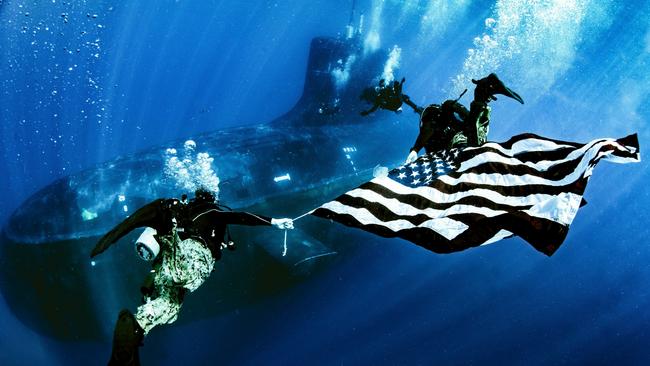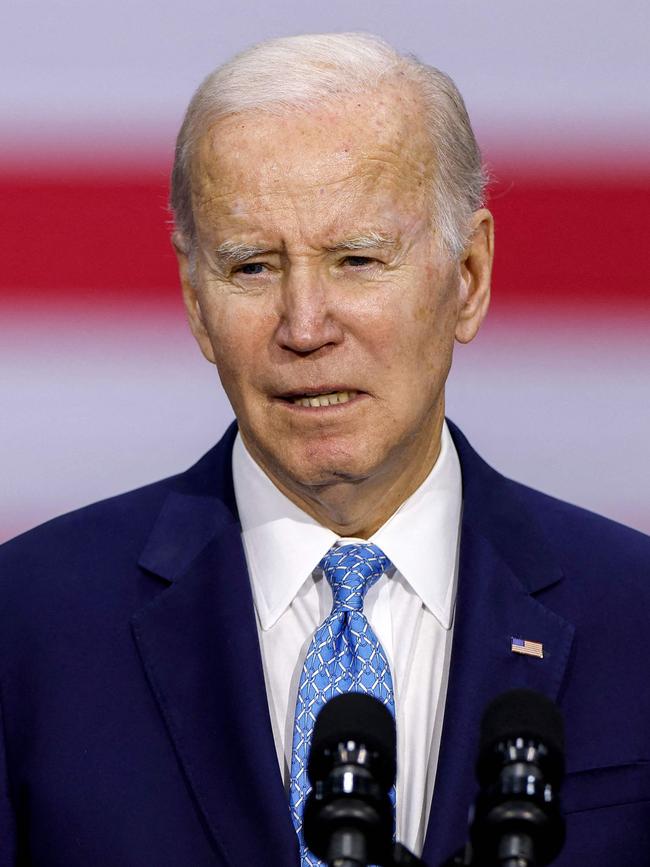AUKUS a deep dive into unknown waters
Australia has embarked on a strategic, technological and economic challenge without precedent. The AUKUS commitments will shape our strategic and industrial policies across the next 40 years.

It is a leap to a more ambitious Australia, but a step heavy with pitfalls. The AUKUS submarine and technological compact, the vision of Scott Morrison, is being implemented by Anthony Albanese and Richard Marles in a bipartisanship sure to test the values, competence and unity of the Labor Party.
The implications are vast. This is the single biggest defence decision since World War II. It locks Australia into a strategic and technological partnership with the US and Britain. The purpose is to strengthen Australia as a decisive force in the Indo-Pacific. It drives a further wedge between Australia and China with unpredictable import. It represents a new defence doctrine of “deterrence at distance” from Australia and will demand a significant long-term increase in the defence budget.
This decision will be unveiled early next week in a joint announcement in San Diego involving the three AUKUS partners – Anthony Albanese, US President Joe Biden and British Prime Minister Rishi Sunak.


Unlocking Australia’s growth potential is the essential mechanism for the Albanese government to deliver on the AUKUS commitments that will shape our strategic and industrial policies across the next 40 years. The Labor Party has now imposed upon itself a series of ambitions that will shape this period of history – the technological upgrade to nuclear-powered submarines, the recasting of our economy given the massive renewable investment needed to achieve its 2030 clean energy transition and the essential shift to a sustainable fiscal position.
The problem is apparent – the chasm between the ambition and the ability to deliver. This government is high on ambition but still too tentative on policy. With its regulatory mindset, reform-shy outlook, politically cautious approach and fixation on culturally progressive goals, the Albanese government seems ill-equipped to mobilise the country for these simultaneous tasks.
Defence Minister and Acting Prime Minister Richard Marles told parliament this week the submarine program would be “a massive industrial endeavour” that would create thousands of jobs and lift the nation’s technological capacity. “It is difficult to overstate the step that, as a nation, we are about to take,” Marles said of the coming announcement.
Yet doubts remain whether the public, the parliament and established power centres in defence and industry are ready for the job. This is a generational challenge. The submarine decision comes in a context of warning signs. First, as Albanese has already discovered, it now costs more to run Australia and to finance the rising social demands of the population, an inescapable political truth.
Second, the competition for funds at the cabinet table will grow only more intense as Labor must arbitrate over priorities, the most agonising choices being between defence and national security, on the one hand, and the caring economy, the National Disability Insurance Scheme, health, welfare and aged care on the other. Third, success will be tied to economic and financial strength – Australia needs a sustained uplift in its economic growth performance to finance these demands within an acceptable political framework.
Delivering the submarine program with a higher defence budget amid a population that constantly increases its social demands on the national budget means a reconciliation is possible only with an improvement in our economic growth performance.
Does Albanese have any delivery mechanism in his mind? He has made two rock-solid promises about the submarine program – it will be “absolutely sovereign 100 per cent” and fully financed according to its needs. These are daunting promises. But they are just the start. Beyond that, he promises to fund the care economy that is pivotal to Labor’s voting support. He pledges to see through the energy transition and run a responsible budget that reduces the deficit. Something, somewhere has to give in this near herculean agenda.

Defence analyst and submarine expert Marcus Hellyer, now head of research at Strategic Analysis Australia, tells Inquirer: “I don’t know how we acquire nuclear-powered submarines, a fifth generation air force, a robust army, a cyber capability, all on 2 per cent of GDP being spent on defence. You can’t have this wish list on the current defence budget.”
Hellyer estimates, depending on the boat, the cost of the nuclear submarine program in 2021 dollars in the $70bn-$78bn range or $150bn-$170bn taking inflation into account – with the current total defence budget running at $48bn or about 2 per cent of gross domestic product.
“The demands for more defence funding can only be met by taking away expectation from other people,” Hellyer says. “Whether you’re this government or the previous government, the view is that we need an independent, sovereign, long-range capability, but the more sovereign capability you want, the more it costs. What is the cost? Maybe it is 3 per cent of GDP, perhaps 2.5 per cent or a bit more. It depends upon the capability.”
Former Defence Department secretary Dennis Richardson tells Inquirer: “I have consistently said I believe that as we move through the 2030s the defence budget will need to grow to 3 per cent plus of GDP to accommodate the nuclear-powered submarines and other capabilities that we need.
“There was funding set aside for the French boats of about $90bn and the nuclear-powered boats will cost far more. We are going to be engaged in an industrial enterprise of a kind we have not experienced before.” A shift from 2 to 3 per cent of GDP on defence is a 50 per cent lift in the defence budget. Will Labor possess the political resolution to embark on that trajectory?

Media reports suggest Australia may have a dual submarine policy – rotating US subs through this country and then buying a number of US-designed Virginia-class subs as early as 2027, jointly crewed and used for Australia’s training, and then commit to a joint build for a UK-Australian boat based on Britain’s Astute-class with a US combat system.
If accurate, this is a decision of genius devised by Marles and our review team or an excessively complex set-up that Hellyer says could be “a form of high-cost duplication”.
“If you set up a Virginia-class capability and then move to a British design, it seems an extraordinary and costly joint track,” Hellyer says. “The more duplication, the more cost.”
There are many imponderables. How will Australia buy Virginia-class subs given the overloaded US production line for America’s own needs? The spectre of Australian investment in the US has been raised. How will joint construction be managed between Britain and Australia of the new submarine? How will South Australia respond to any delayed timetable for submarine construction in Adelaide? How much of a solution is this arrangement to our long-debated submarine capability gap?
There was strong bipartisan agreement across the chamber this week with Peter Dutton ahead of the announcement, saying: “We will support the decisions of the government under AUKUS and fight to make sure the outcome is achieved as quickly as possible.” Both Marles and the Opposition Leader emphasised the submarine decision was designed to contribute to the “peace and security” of the region, given concerns in Southeast Asia.
They recognised Morrison’s role. AUKUS was a Morrison initiative where he won the support of then British prime minister Boris Johnson and subsequently of Biden for the three-way project. It is an exceptional event for an Australian leader to devise and carry through an initiative with such strategic potential in the region and the world.
If Albanese and Marles succeed, the irony is they will realise Morrison’s vision.
In this case the anger of French President Emmanuel Macron and the election damage done to Morrison by Macron’s personal criticism will be long forgotten while Morrison’s legacy will endure and become a point of reassessment of his prime ministership.
Labor will operate with a serious constraint – it wants to avoid talk of an existential security crisis or invoking China as the threat because it seeks to improve relations with China. But how will China react to the tangible development of the US-UK-Australia nuclear-powered submarine and tighter defence technology partnership? This will complicate Labor’s relations with Beijing.
Have no doubt next week’s announcement will provoke more angst about AUKUS as its consequences become clearer. Former prime ministers Paul Keating and Malcolm Turnbull have been strong critics. Concern on the political left is sure to intensify. Perhaps it is desirable that Albanese and Marles must manage the backlash, not Morrison.
In a recent analysis for the Australian Strategic Policy Institute, Hellyer wrote: “There’s no pot of gold available to cover increased defence spending. That doesn’t mean the government can’t or won’t increase defence spending but any increase will require either higher taxes (which appears unlikely since the government is proceeding with its predecessors planned tax cuts), greater borrowing (accelerating the vicious cycle of debts and deficits) or cuts to other priorities that have constituencies of the own.”
Hellyer says defence has to sort its priorities between big-spending mega projects with long lead times and the urgent need for force projection in the near term. Labor needs to lift defence spending as a proportion of GDP, but how does it win popular support for guns over butter?
Everything points in one direction – stronger economic growth is imperative. Labor needs an effective growth strategy beyond the inflation-induced downturn caused by the interest rate rises of the Reserve Bank. Creating a larger economic pie for Albanese’s expansive and multiple demands is the only way through.
But this won’t be easy. Labor’s economic growth strategy looks dubious. This week the inaugural chairman of the Productivity Commission, Gary Banks, lamented the decline in Australia’s public policy and economic reform agenda over the past generation. Economic under-performance and poor productivity, if perpetuated, will threaten the AUKUS project since that requires new learning, high skills, technological sophistication, public investment and a new class of submariners.
Independent economist Chris Richardson tells Inquirer: “We have a $50bn annual hole in the budget and weak productivity growth. Australia at present doesn’t look as though it can rise to challenges as effectively as we did before. The political pendulum has swung in favour of the status quo. It’s harder to get change.”
That’s an ominous warning because AUKUS will demand a dynamic response and bold policy from Australia if it is to succeed. Richardson points out the upfront costs of the submarine project are not huge but increase over time. Higher defence spending, however, must be extracted from a budget running a structural deficit of about $50bn annually equivalent to 2 per cent of national income.
Where will the future economic growth come from? Richardson says while productivity is weak, population growth is returning. It may not be the optimal means of driving Australia’s economic growth but stronger population can lift GDP and help underpin the needs of the defence budget.
The AUKUS announcement will be an integral step in the new defence doctrine being shaped by Marles, the cornerstone of which is holding potential adversaries at a distance through the ability to project military force. The submarines, Marles says, are “at the heart” of force projection.
His foundational principle is that the US alliance and tighter technological and strategic links to the US “builds our sovereignty”.
You can be sure of one thing: Albanese and Marles will need to convince their own side of politics on that principle.






Australia has embarked on a strategic, technological and economic challenge without precedent – seeking to become the world’s seventh nuclear-powered submarine country. This is a whole-of-nation task that transcends defence procurement and penetrates to our financial, human capital and leadership capabilities.